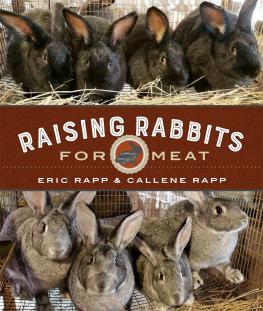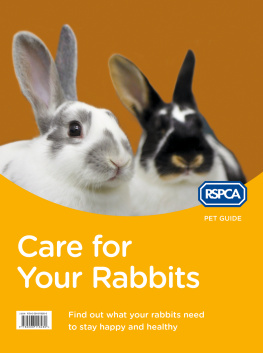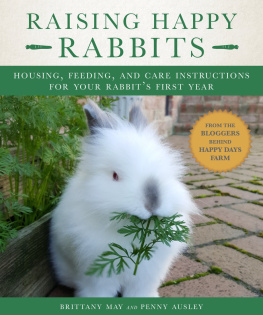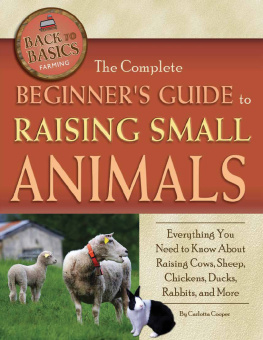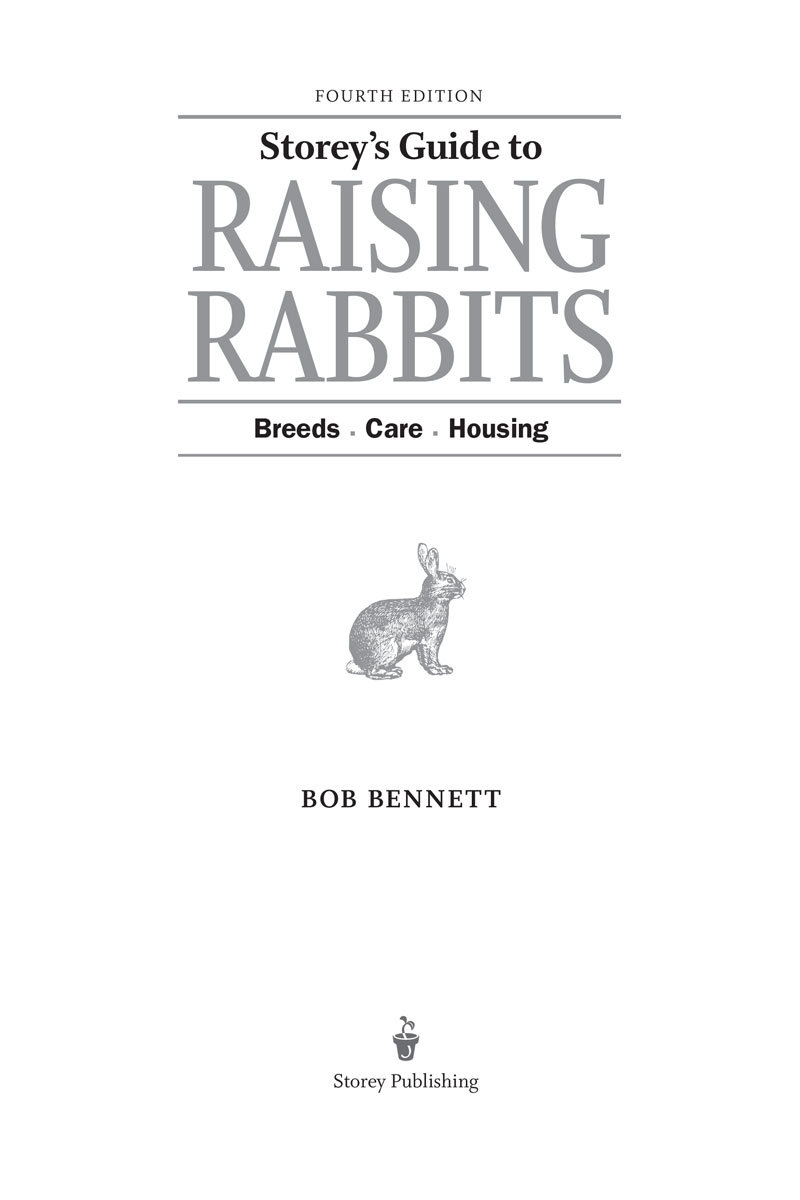The mission of Storey Publishing is to serve our customers by
publishing practical information that encourages
personal independence in harmony with the environment.
Edited by Rebekah Boyd-Owens, Sarah Guare, and Deborah Burns
Art direction and book design by Cynthia N. McFarland
Cover design by Kent Lew
Text production by Erin Dawson
Front cover photograph of Checker Giant/New Zealand Cross by Jason Houston
Interior photography courtesy of the American Rabbit Breeders Association:
Illustrations Elayne Sears, except for those on
Rabbit papers and certificates courtesy of the author
Expert reader: Lindsay Benoit
Indexed by Christine R. Lindemer, Boston Road Communications
2009, 2001 by Bob Bennett
Ebook production by CodeMantra and Kristy L. MacWilliams
Ebook version 1.0
July 1, 2014
All rights reserved. No part of this book may be reproduced without written permission from the publisher, except by a reviewer who may quote brief passages or reproduce illustrations in a review with appropriate credits; nor may any part of this book be reproduced, stored in a retrieval system, or transmitted in any form or by any means electronic, mechanical, photocopying, recording, or other without written permission from the publisher.
The information in this book is true and complete to the best of our knowledge. All recommendations are made without guarantee on the part of the author or Storey Publishing. The author and publisher disclaim any liability in connection with the use of this information.
Storey books are available for special premium and promotional uses and for customized editions. For further information, please call 1-800-793-9396.
Storey Publishing
210 MASS MoCA Way
North Adams, MA 01247
www.storey.com
To my mother,
who helped me to start right,
and
to my wife,
who encouraged me to continue
Contents
Preface
IN 1948, AS A BOY IN VERMONT, I started raising rabbits right because Tony Pisanelli had my best interests at heart. He made sure I began with good rabbits! My backyard hutches produced not only lots of rabbits but also spending money and time left over to spend it, not to mention a few extra dollars to put in the bank. I won a trophy and a few ribbons and earned a Boy Scout merit badge, too. And the rabbit dinners from that era are unforgettable.
Fifteen years after Tony got me going after college, military service, and apartment life I returned to my boyhood pursuit of rabbit raising in the backyard, and at this writing, more than 60 years later, I remain happily hot at it. After raising the animals myself and watching others try it with varying results, Im prompted to pass along the tried-and-true as well as the newer ways I learned from Tony and many others ways to house, feed, breed, show, and sell rabbits. My own experience includes building five rabbitries in two states and a stretch of six decades of raising these versatile animals.
When I recall my days as a Scout, I remember that my original reason for pursuing the rabbit-raising badge was the thought that the rabbits would do most of the work, leaving me time to pursue other badges as well as part-time jobs, and yes, even schoolwork. I needed 21 badges to make Eagle, my original goal. Some were mandatory, and I had those. The rabbit-raising badge was among the optionals.
I still have the uniform sash with all the badges my mother stitched to it. The twentieth badge was Rabbit Raising. She had hoped to sew on one more and be the mother of an Eagle Scout. It was not to be. My interest in pursuing another badge waned, but I raised lots more rabbits during my high-school days. The rabbits continued to do most of the work and to produce some of the spending money that high-school boys think they require.
The Boy Scout episode led to another one years later, which actually resulted in the publication of this book. A neighborhood Scout knew I raised rabbits and asked if I would be his counselor and help him earn that badge. Sure, I told him. Just get the booklet that outlines the requirements and we will get to work. To my surprise, it was the same booklet I had used 20 years earlier. George Templeton wrote it when he ran the United States Rabbit Experiment Station near Los Angeles, where most of the nations meat rabbits were produced until rising real estate value dispatched them to the Ozarks in the 1950s, and President Eisenhower revoked funding for the federal facility.
Advances in feeds, tools, equipment, and management practices occurred during subsequent years; by the 1970s, that little manual really needed an update. George Templeton had passed away, so the ex-journalist in me produced a new one for the Boy Scouts. The national publicity it received when it appeared suggested to some that I should produce a full-length book for everyone, not just Scouts.
This is it. Sort of.
For years after its publication, the mothers of Scouts across the country sewed that badge onto 80,000 uniform sashes; it was earned by Scouts who followed the requirements and instructions in the new manual, which gave my own mother some measure of satisfaction. Since then, more than 250,000 would-be and experienced rabbit raisers have read it; it has been reprinted about 60 times in a succession of expanded and updated editions as well as some translations. This new edition has been updated, revised, and expanded once again. The information is solid, the techniques tried and true. Thats not to say you cant do things differently rabbits are resilient creatures. But the methods here have led to unparalleled success.
When this book debuted, it was called Raising Rabbits the Modern Way. It contained only 150 pages. Originally, I drew heavily on the wisdom and experience of Tony Pisanelli and others of his generation. Over the years since then, I have visited many rabbitries, attended shows and conventions, and spoken with many groups of raisers and suppliers to the industry. I have maintained correspondence with literally thousands of readers, many of whom have contributed their expertise, tips, and techniques. You will meet several of them in these pages. My postal and e-mail addresses are in the book, and I would be happy to hear from you, too.
Because of all the good, solid information based on the experiences of so many people, I have been writing and rewriting this book for half of my life so far. I hope you will enjoy reading it. Tony Pisanelli would be pleased. I also strongly suggest that you join the American Rabbit Breeders Association. After serving the ARBA as a board member, and founding and editing its Domestic Rabbits magazine, I know that the organization has a lot to offer both beginning and advanced rabbit raisers. If you want to be successful with rabbits, read this book and join the ARBA.
Bob Bennett
Shelburne, Vermont
Spring 2009
ACKNOWLEDGMENTS
I am very grateful to the following persons for their expertise and encouragement: Anthony Pisanelli; Robert Noble; Charles Lyons; Charles Maurer; Frank Miglis; Robert Densmore; Ted, Flo Ann, and Tammy Gordon; James Blyth; John Dack; Frank DelMastro; Pat Schmidt; H. John Nelson; Oren Reynolds; Robert Dubbell; Edward Peifer; Edward Stahl; Bill Dorn; Paul Posel; J. Calvin Downing, DVM; Jerry Belanger; Sam Mines; H. Joseph Hull; Ron Epstein; and Lindsay Benoit.



